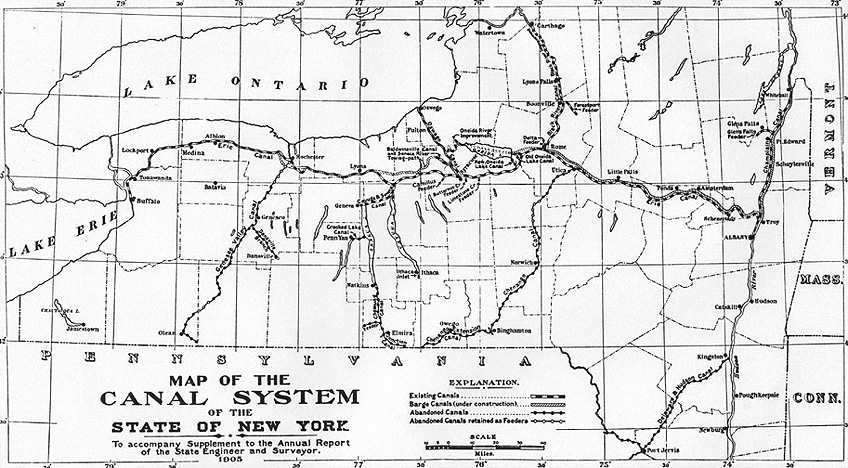Map of the Canal System of the State of New York
To accompany Supplement to the Annual Report of the State Engineer and
Surveyor, 1905


There were innumerable engineering challenges for the Canal to surmount and considerable political, commercial, and economic opposition. To demonstrate the Canal's success and silence the very vocal critics, construction began at the easiest, 80 mile non-lock section east and west of Rome, and was opened immediately upon completion. The next phases, however, presented endless complications. The Canal had to rise through a series of locks from the Hudson to an elevation of 420 ft. at Rome and then descend to 363 ft. and rise again to a final height of 565.5 ft. at Lake Erie.
From New York City to the Great Falls at Cohoes, no locks were required. But then, 20 locks had to be constructed to lift the Canal a total of 160 ft. from the Hudson to the Mohawk River. Later, the Enlarged Canal reduced the number to 16 locks with a lift of 163.6 ft. and the current Barge Canal which goes through the town of Waterford has 5 locks with a lift of 169 ft. The next challenge was at Little Falls.
To reach Lake Erie, the Canal must surmount the Niagara Escarpment, a geological feature between Rochester and Buffalo, where the land rises sharply over a rocky ridge. Because the size of lock gates is limited to that which can be operated by a single individual, this rise could not be handled by one or two large locks. Because the rise is abrupt, it could not be handled with several locks separated by stretches of Canal. The 60-foot rise was therefore achieved by five adjacent double locks, each feeding directly into the next, forming a single integrated structure. This "flight" of Lockport locks constitutes the most famous structure on the Canal.
In 1825, the last exceptionally difficult section of the Canal through Lockport was completed. The route over the Niagara Escarpment at Lockport was chosen to channel a continuous supply of Lake Erie water into the Canal. In order to maintain the required gradient for the flow from Lake Erie (572 ft.) through the Canal not only did the locks have to be cut into the rock face of the escarpment but a 7 mile channel varying from 12 to 30 ft. deep had to be excavated in the solid rock.
The following is an excerpt from the Diary of Jonathan Pearson:
Thursday, August 8, 1833
"In this place is the most stupendous work on the whole Canal. The 65-mile level ends at the
foot of the mountain ridge which is surmounted by five double locks constructed in the most
durable and finished manner. These are looked upon as the most perfect specimen of
architecture of the kind on the whole Canal or in the country. Each lock must be as much as 12
or 15 ft. lift, making in all a rise of 60 ft. or 75 ft. The stone, which was obtained in a quarry
nearby resembles very much the Quincy granite and is hewn in the neatest style. The surplus
water of the Canal runs off at the upper level and is carried around the side of the hill supplying
numerous mills with water. A cotton factory is now under way or about to be in the lower
town."
"From Lockport to Pendletown, a distance of seven miles, the Canal is made by excavating to the depth of from 30 to 50 ft., the deepest part of which excavation for nearly three miles is thro a solid rock of limestone. As one passes along this deep cavern and sees the immense piles of decaying limestone on either side, which have been thrown out by machinery, and the rough perpendicular walls pierced in every part with drill-holes used for blasting the rock, he is astonished at the perseverance, labor , and expense which it cost .... The reason why this was cut so deep and at such expense instead of locking up and down, which would have been much cheaper and easier, is because there is no supply of water for the purpose at any greater height."
http://www.eriecanal.org/UnionCollege/Making_It_Work-add.html